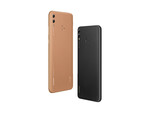Huawei Y Max
Especificaciones de Portátil(es)

Cámara secundaria: 8 MPix f2.0
Price comparison
Análisis para el Huawei Y Max
Origen: Yugatech
 EN→ES Archive.org version
EN→ES Archive.org versionThe Huawei Y Max is something that we would consider a next-gen “phablet”. Even though smartphones are going for 6-inch screens, the Y Max’s 7.12-inch is still quite a handful. Still, it looks good thanks to the faux leather design and slim bezels. Some may not like it, and that’s okay, but those who are looking for something great for binge-watching on Netflix or YouTube or for playing games, will find this device perfect.
Único Análisis, disponible online, largo, Fecha: 03/30/2019
Origen: Tech Nave
 EN→ES Archive.org version
EN→ES Archive.org versionCurrently, the device is only priced at RM1299, which is not too shabby considering how large the display is. Not only that, but it also comes with a “leather” back which is quite satisfying to hold. If you prefer a smartphone with a large display and equally large battery for mobile gaming and watching videos, the Huawei Y Max might be the device for you. If you are interested in getting such as device, do stop by Huawei’s official website and for more updates like this stay tuned to
Único Análisis, disponible online, corto, Fecha: 01/18/2019
Origen: Tech Nave
 EN→ES Archive.org version
EN→ES Archive.org versionSo if you’re an avid movie watcher who loves the Gold Class treatment anywhere and anytime, this is definitely the device for you. If you want to get your own Huawei Y Max, you can head on over to any Huawei Experience stores or the official Huawei website. For more interesting innovations and news, make sure to keep an eye out on TechNave.com!
Único Análisis, disponible online, corto, Fecha: 01/14/2019
Comentario
Qualcomm Adreno 512:
Tarjeta gráfica integrada basada en la arquitectura Adreno 500, como la Adreno 520 del Snapdragon 820. Según Qualcomm, es hasta un 30% más rápida que la generación anterior (¿Adreno 510?). Soporta DirectX12, OpenCL 2.0, OpenGL ES 3.1 + AE.
Estos procesadores gráficos pueden mostrar únicamente juegos antiguos, fluidamente. Juegos actuales pueden ser presentados con detalles sustancialmente reducidos.
>> Más información puede ser encontrada en nuestra comparación de tarjetas gráficas moviles y la lista de benchmarks.
SD 660:
Veloz SoC ARM de gama media con 8 núcleos de CPU Kryo 260 (cuatro núcleos veloces a 2,2 GHz en un cluster y dos núcleos de 1,8 GHz ahorradores de energía) y una GPU Adreno 512 bastante lenta. Producido en un proceso de 14 nm.
>> Más información puede ser encontrada en nuestra comparación de procesadores móviles.













